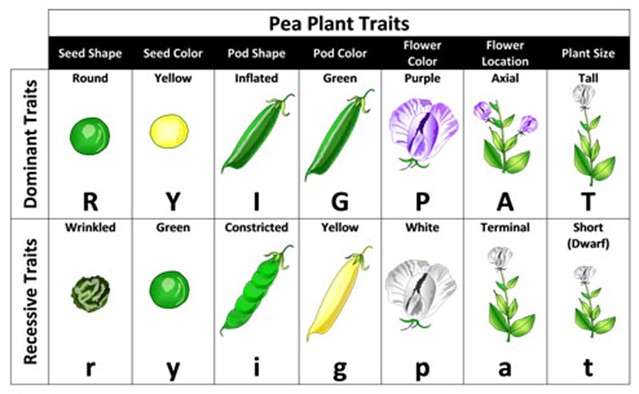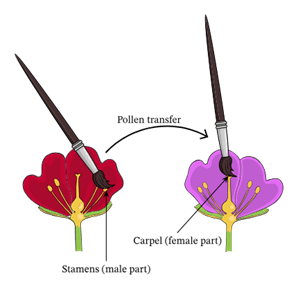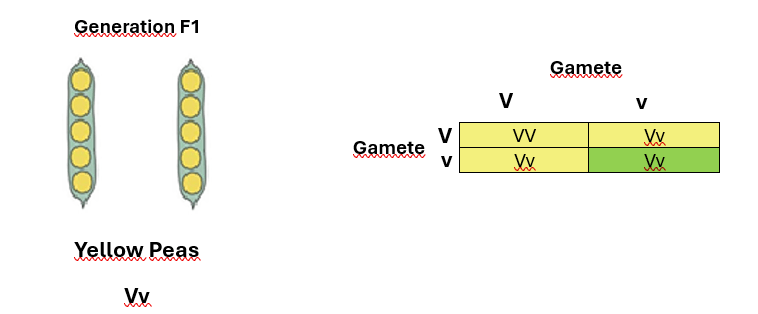The scientist Johann Gregor Mendel (1822-1884), known as the “Father of Heredity”, was responsible for some of the most important discoveries in the field of biology. Mendel began studying genetic inheritance in 1856 with the idea that heredity would be transmitted in portions.
First of all, in any experiment it is important to define a model system for the implementation of the studies. A model system consists of the organism or species that the scientist chooses to implement their studies. The process of selecting a model organism is specific and depends on a number of factors (ethics, development of the organism, etc.)1.
Mendel used various organisms as model systems. He began by using mice, but the final model system he used was peas, having carried out experiments with almost 30,000 plants.
In 1865, Mendel published his studies on Heredity in an article called “Experiments in the Hybridization of Plants” 2. Through his experiments with peas, which we will detail in a moment, then he opened the door to knowledge of Heredity, not only in this species, but in many others that follow the pattern of segregation explained by Mendel. We will now analyze how Mendel reached these conclusions about Heredity, examining in detail each of the Laws presented by the scientist.
Mendel’s First Law
Starting with Mendel’s first law, also known as the Law of Segregation of Factors. Firstly, we have to bear in mind that at this time there was no concept of a gene3, so Mendel called the structures that could be transmitted between individuals and which would be responsible for certain characteristics “factors”. Today, we clearly know that these “factors” are the genetic alleles (V, v).
As mentioned earlier, Mendel used peas (Pisum sativum) as his object of study. Compared to many mammals, peas are a fast-growing plant species with a short life cycle. In addition, peas produce a large number of seeds in a short space of time and there are no ethical issues surrounding their use. Mendel saw that he could use these seeds as the basis of his study and monitor them easily, since these organisms have easily identifiable characteristics.
Then he observed 7 distinctive characteristics of these peas and used them as a basis for study. The respective characteristics observed are shown in the following table, where we can see that for each characteristic there is a Dominant and a Recessive condition4.

Fig. 1- Characteristics observed by Mendel in peas. Each characteristic has a dominant condition and a recessive condition Source: Ontrack
Mendel Experiment
To study the characteristics described above in peas, Mendel used extremely precise fertilization. In other words, Mendel used a pollination brush, removing pollen from one plant and inserting it into another. This process is called cross-pollination. Complementing the advantageous characteristics of peas described above, we can add that Mendel’s process of cross-pollination also benefited from the fact that peas had a more closed flower, which made Mendel’s processes more precise and made artificial pollination easier.
Through this process of cross-pollination, Mendel began to test the various combinations of these characteristics. For example, with regard to the characteristic Color, Mendel found that there were plants that gave rise to green peas, while others gave rise to yellow peas, and he crossed the two plants to see what the characteristics of the organism resulting from the cross would be.

Fig. 2- Mendel’s Cross Pollination Source: Nagwa
It is important to note that in Mendel’s First Law, he studied each of the characteristics listed above for peas in turn. In other words, each characteristic of the peas was studied individually and not several characteristics simultaneously. This last condition will be discussed later in Mendel’s Second Law.
This condition in Mendel’s First Law is called Monohybridism5, i.e. it is a type of genetic cross where the inheritance of a single character, determined by a pair of alleles, is analyzed.
Mendel’s Pure Peas
Mendel also defined lineages of Pure Peas, which we now call Pure Lineages. We can consider a Lineage to be Pure when the characteristic in question is maintained throughout the generations. For example, when Mendel crossed plants that gave green peas with others that gave green peas and the generation showed the same characteristic throughout the generations, this meant that it was a pure lineage. This is true, of course, for the “Color” trait, but it applies to all traits studied individually. These individuals can be considered homozygous (vv or VV).
Let’s now take a look at one of Mendel’s experiments, in this case on the trait Color.

Fig. 3- General Scheme – Mendel’s Crosses and Their Results Source: Human Origin
According to the diagram above, we can see that Mendel used a yellow pea plant and crossed it with a green pea plant. Mendel called this first cross a cross between parental organisms (P). Note that both plants involved in this process are pure. In other words, when crossing plants with the same trait, they produce offspring with the same trait.
We can see that the result of this cross, the F1 generation, consists of all plants with yellow peas.
Mendel’s Sucessive Crosses Experiment
Intrigued by this situation, Mendel made successive crosses between plants of the F1 generation, a process known as backcrossing. From these crosses, Mendel obtained the F2 generation. We can see that in this F2 generation, for every 3 plants with yellow peas, 1 plant had green peas. This gives a ratio of 3:16. (6)
Through this experiment, Mendel posited some rules and determining points:
- He considered that the Green Color trait was inhibited in the F1 generation. This Green Color trait is then called Recessive.
- On the other hand, what manifests itself in the F1 generation is yellow color. This trait is therefore considered dominant over green.
- Mendel assumed that there were two “factors”, one of which randomly went to each gamete.
- Fertilization is the process of bringing these “factors” together.
Let’s explain each of these points mathematically.
Let’s call the factors V (Dominant condition – yellow color) and v (Recessive condition – green color).
As we have seen, Mendel indicated that for any characteristic there were two “factors”. Considering a yellow pea, the factors will be VV (homozygous dominant) or Vv (heterozygous). As for a green pea, the factors will be vv (homozygous recessive).
A homozygous dominant individual, VV, is a pure organism, as is a homozygous recessive organism, vv. This is because they only form one type of gamete. In the case of a VV individual, each gamete can only carry V and in the case of a vv organism, each gamete can only carry v. As we have seen, the crossing of the Parental generation resulted in a new generation of plants (F1), all with yellow peas.

Fig. 4 – Crossbreeding between Parental Organisms and their Offspring
The Discovery Of Dominant And Recessive Alleles
By crossing individuals, we can see that 100% of the plants in the F1 generation show a combination of Vv factors (genotype) and a yellow color (phenotype). Although we have a V factor (dominant) together with a v factor (recessive), the dominant factor (V) is the one that manifests itself. All these individuals are hybrids because they have different Vv factors.

Fig. 5 – Crossing F1 Hybrids and Their Offspring.
Later, we saw that Mendel used backcrossing. He crossed several individuals of the F1 generation (Vv) from a homozygous parental generation. As we can see, by crossing two Vv organisms, we get: 1 VV individual, 2 Vv individuals and 1 vv individual. The first 3 individuals express the dominant condition and the last one a recessive condition. So the first 3 individuals are yellow and the last one is green.
Thus, in this second cross, the proportion found is that for every 3 yellow individuals, one is green, and this proportion is applied to any number of individuals obtained.
Mendel repeated this experiment multiple times, not only with the Color trait, but with all the other traits, verifying that the results were exactly the same.
In order to understand the results of the previous experiments described, it is important to understand the Concept of Allele Segregation that surrounds this first Law.
But What Are These Factors?
Let’s therefore review that the “Factors” mentioned above are the Alleles. These alleles condition the characteristics of individuals. They are segregated (separated) in the process of gamete formation. Consequently, the father donates one of these factors and the mother the other to her offspring7.

Fig. 6 – Explaining Allelic Segregation
Looking at the practical example above, let’s consider that we have both parents. The mother on the left and the father on the right. With regard to the factors (allelic combination) responsible for a given trait. The mother is heterozygous (Aa) and the father is homozygous (AA). These factors, when it comes to forming gametes, will be one factor for each gamete. In other words, each parent transmits only one of their alleles to the offspring, allowing each offspring to carry a hereditary factor from each parent.
This situation applies to various characteristics and every gene in our body. When individuals are crossed, we obtain a variety of possible combinations which are the basis of the phenotypes manifested and which are explained by Mendel’s first law8.
Footnotes
- Rye, C., Wise, R., Vladimir Jurukovski, DeSaix, J., Choi, J., & Avissar, Y. (2016b). 12.1 Mendel’s Experiments and the Laws of Probability – Biology | OpenStax. Openstax.org; OpenStax. ↩︎
- Mendel, G. (1865). EXPERIMENTS IN PLANT HYBRIDIZATION (1865). ↩︎
- Czech, M. (2023). Mendel’s experiments – WikiLectures. Wikilectures.eu. ↩︎
- Miko, I. (2008) Gregor Mendel and the principles of inheritance. Nature Education 1(1):134 ↩︎
- Federal University of Pelotas ↩︎
- Mendelism ↩︎
- McClean, P. (2001). Mendelian Genetics. Ndsu.edu. ↩︎
- Information taken from: “Biologia com Samuel Cunha” ↩︎
Thank you for reading. If you’re curious and want to learn more, go to the “articles” section. Every week there are new articles published and new curiosities, stay tuned! Subscribing to our Newsletter will notify you when a new article drops.
Read Next
